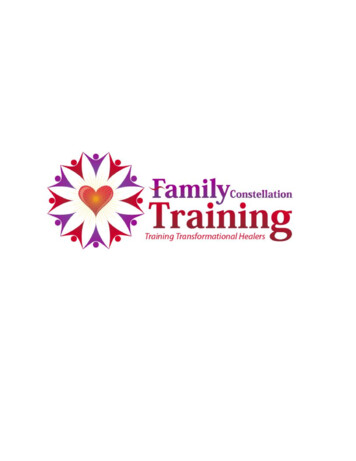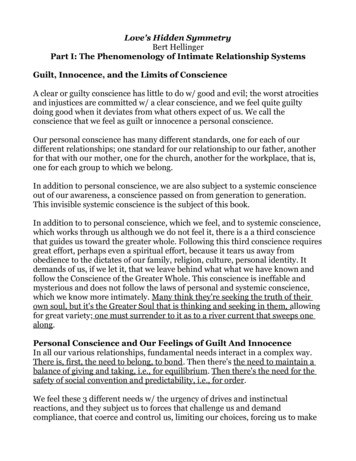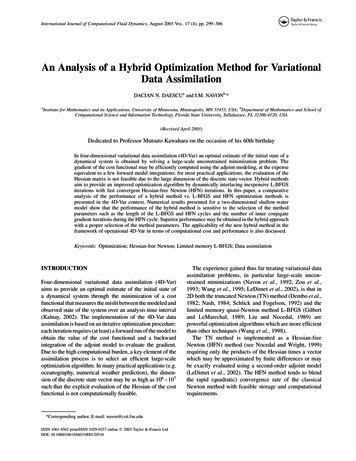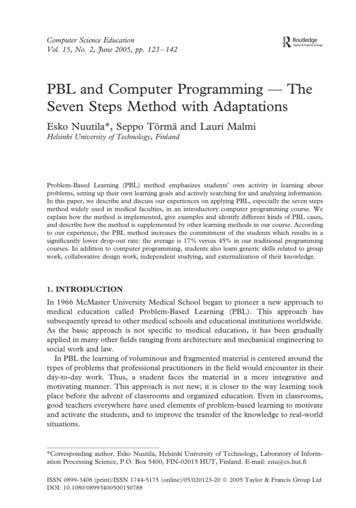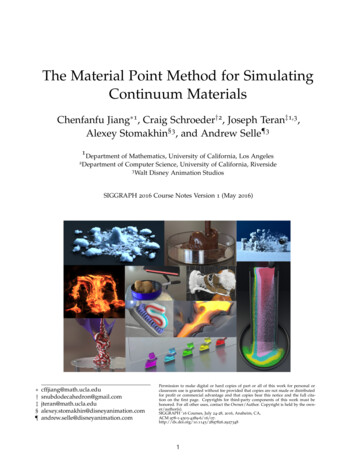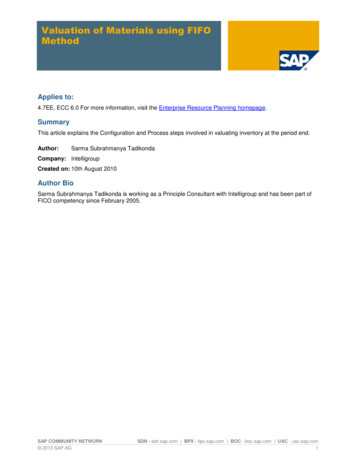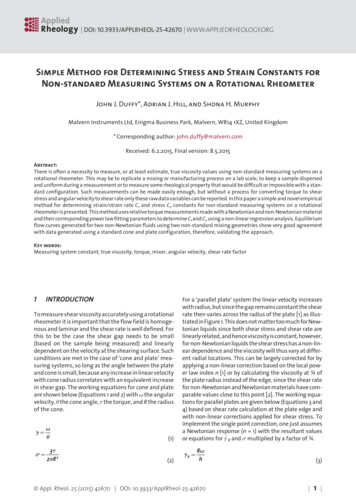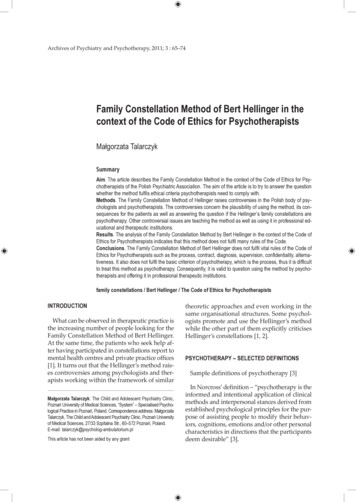
Transcription
Archives of Psychiatry and Psychotherapy, 2011; 3 : 65–74Family Constellation Method of Bert Hellinger in thecontext of the Code of Ethics for PsychotherapistsMałgorzata TalarczykSummaryAim. The article describes the Family Constellation Method in the context of the Code of Ethics for Psychotherapists of the Polish Psychiatric Association. The aim of the article is to try to answer the questionwhether the method fulfils ethical criteria psychotherapists need to comply with.Methods. The Family Constellation Method of Hellinger raises controversies in the Polish body of psychologists and psychotherapists. The controversies concern the plausibility of using the method, its consequences for the patients as well as answering the question if the Hellinger’s family constellations arepsychotherapy. Other controversial issues are teaching the method as well as using it in professional educational and therapeutic institutions.Results. The analysis of the Family Constellation Method by Bert Hellinger in the context of the Code ofEthics for Psychotherapists indicates that this method does not fulfil many rules of the Code.Conclusions. The Family Constellation Method of Bert Hellinger does not fulfil vital rules of the Code ofEthics for Psychotherapists such as the process, contract, diagnosis, supervision, confidentiality, alternativeness. It also does not fulfil the basic criterion of psychotherapy, which is the process, thus it is difficultto treat this method as psychotherapy. Consequently, it is valid to question using the method by psychotherapists and offering it in professional therapeutic institutions.family constellations / Bert Hellinger / The Code of Ethics for PsychotherapistsINTRODUCTIONWhat can be observed in therapeutic practice isthe increasing number of people looking for theFamily Constellation Method of Bert Hellinger.At the same time, the patients who seek help after having participated in constellations report tomental health centres and private practice offices[1]. It turns out that the Hellinger’s method raises controversies among psychologists and therapists working within the framework of similarMałgorzata Talarczyk: The Child and Adolescent Psychiatry Clinic,Poznań University of Medical Sciences, “System” – Specialised Psychological Practice in Poznań, Poland. Correspondence address: MałgorzataTalarczyk, The Child and Adolescent Psychiatry Clinic, Poznań Universityof Medical Sciences, 27/33 Szpitalna Str., 60–572 Poznań, Poland.E-mail: talarczyk@psycholog-ambulatorium.plThis article has not been aided by any granttheoretic approaches and even working in thesame organisational structures. Some psychologists promote and use the Hellinger’s methodwhile the other part of them explicitly criticisesHellinger’s constellations [1, 2].PSYCHOTHERAPY – SELECTED DEFINITIONSSample definitions of psychotherapy [3]In Norcross’ definition – “psychotherapy is theinformed and intentional application of clinicalmethods and interpersonal stances derived fromestablished psychological principles for the purpose of assisting people to modify their behaviors, cognitions, emotions and/or other personalcharacteristics in directions that the participantsdeem desirable” [3].
66Małorzata TalarczykAccording to Urban and Ford – “psychotherapy is still a well-thought-of, and in that matter, planned form of intervention into behavioral circumstances of a particular person for thepurpose of correcting or modifying the attitudepresented by them towards a specific type of difficulties” [3].The definition of psychotherapy by professorAleksandrowicz states: “Psychotherapy is sucha form of psycho-social interactions which aimsto correct disorders of experiencing and behaving, is supposed to remove symptoms and causes of an illness including personality traits thatcause disorders of experiencing. These interactions, influencing a functional state of organs aswell as experiencing and behaving through thechange of mental processes of the patient, are exerted within the framework of interpersonal relationship between two people or in a group inwhich a psychotherapist simultaneously treatsseveral persons” [4].Professor Czabała [3] points out differences inunderstanding these definitions of psychotherapy. In the first definition “assisting” people inchanges, which are deemed desirable, is emphasised while the second one is based on helpingwith the modification of attitudes that hampersolving difficult situations. In the third definition the attention is paid to the change of mental processes, which the therapist considers necessary to correct disorders of a functional stateof organs, disorders of experiencing and behaving.Czabała emphasises that the problem of changeis the most important element of psychotherapy.“Psychotherapy, as a method of treatment, aimsto bring about changes that will allow removing or decreasing the intensification of symptoms” [3]. In the introduction to the book entitled Czynniki leczące w psychoterapii [Curing factors in Psychotherapy] he shares his own reflection stating that “psychotherapy is a methodof treating mental disorders the application ofwhich requires knowledge referring to the results of scientific studies and abilities that canbe acquired as a result of learning. Psychotherapy is an art only in a sense that every psychotherapist proportions the acquired knowledgeand abilities to his or her own potential of usingthem and needs that stem from individual problems of the patient” [3].According to Czabała and Brykyczyńska [5]– “psychotherapy fulfills theoretical requirements in order to be considered scientific. Theproblem is the fact that the results of empiricalstudies do not unambiguously prove the validity of theoretical statements of many theories.During the last years more empirical facts haveappeared which suggest that changes takingplace in the course of psychotherapy are connected with the variables of the process of psychotherapy” (The summary of the presentationmade at the conference entitled “Podstawy naukowe psychoterapii” [Scientific bases of psychotherapy]). In the summary of the lecture givenduring the aforementioned conference that tookplace in Warsaw in June 2010 J.W. Aleksandrowicz writes among others: „what is called psychotherapy is helping healthy people with decreasing their dissatisfaction with their own functioning, gaining knowledge about themselves, capability in interpersonal relationships etc. as wellas treating health disorders, especially functional disorders. In the first of these versions, psychotherapy is inscribed in the field of social sciences while in the second one it is a part of medicine ( ). Much indicates that putting the discipline of psychotherapy within the framework ofscience requires among others clear distinctionof psychosocial interactions that act as help fromtreating health disorders [6].According to the author of the article the proposed distinction between psycho-social actionswhich act as help and treating health disorders[6] can not only be conducive to distinguish therapeutic approaches classified as psychotherapyas a method of treatment but can also be helpful in taking an attitude towards the Hellinger’smethod.In the context of the presented definitions,a question is raised whether the family constellation method of Bert Hellinger fulfils the criteria of psychotherapy.FAMILY CONSTELATION METHODOF BERT HELLINGERIn the note about the author of the book entitled Porządki pomagania, czyli jak, kiedy I komu skutecznie pomagać [Orders of helping, i.e. how, whenand who to help effectively] [7] we can read: „BertArchives of Psychiatry and Psychotherapy, 2011; 3 : 65–74
Family Constellation Method of Bert Hellinger in the context of the Code of Ethics for PsychotherapistsHellinger, one of the most outstanding modernpsychologists, spent 25 years in a convent, including 16 years as a missionary to the Zulu. Hestudied philosophy, theology and pedagogy,gained extensive psychological education [ ]He discovered entanglements of an individualinto present and past vicissitudes of family life.He developed an original method of orderingentangled and broken bonds – family constellations” [7].The introduction to the book includes Hellinger’s reflections on helping which he formulated as “five orders”. In his opinion “helpingis an art. And, as every art, it requires certainskills. They can be learnt. It is also an ability toshow empathy to a person seeking help. Empathising enables to learn the situation of the other person and notice both the limitations as wellas the thing that makes it possible to go beyondthem” [7]. According to Hellinger – “the first order of helping is the rule, that you can give onlywhat you yourself possess and that you expectand take only what you need” [7]. In the opinionof the article’s author, it is difficult not to agreewith that rule as far as by the expression “whatyou yourself possess” we understand not onlypersonality-based predispositions and life experience of the “helper” but also his or her knowledge on the field psychopathology and psychotherapy as well as clinical and therapeutic experiences.“Second order of helping” on the one handserves to survive and on the other one contributes to development and growth. Survival, development and growth depend on specific external and internal circumstances. “Second order of helping is based on accepting limitationsand help (sustaining intervention) which reaches as far as it is indispensable. Such helping is restraining. It has power” [7].In the “third order of helping”, Hellinger concentrates on setting boundaries and processes of transference and counter-transference.“Many helpers yield to transference and counter-transference from a child to a parent and asa result make it difficult for their clients to partboth from the parents as well as themselves” [7].“The third order of helping – concerns the situation when a helping adult gives help to anadult seeking help [ ] In that case the negationof helping is to allow an adult client to make67demands of the helper, the kind of demands achild makes of his or her parents. It is also allowing the helper to treat the client as a child: in thatway he or she deprives the client of the possibility to take responsibility and the consequences,which he or she can, or even need to take himself or herself” [7].While describing the “fourth order of helping”Hellinger writes: “classical psychotherapy treatsthe client as a separate individual. When taking such an approach persons who help are easily in danger of child-parent transference [ ] Itmeans that the helper should treat the problemsystemically not personally. The point is thatthe helper does not get into a personal relationship with the client. This is the fourth order ofhelping” [7]. Thus, in the fourth order of helping Hellinger brings up ethical issues which areincluded in the Code of Ethics for Psychotherapists[8]: “Therapist is not allowed to transfer the relationship with the person being treated beyondthe area of the therapy” – I. General Principles,point 4. [8].“The fifth order of helping – family constellations – aims to connect what has been dividedand parted. In this sense, they serve to conciliate,in the first place with the parents [ ] Many helpers follow their own conscience and judgments[ ] Because of that, help may only be given bythe person who is able to place in their soul boththe person of the client as well as things the client complains about. The helper is the first oneto accomplish in his or her soul what the clienthas to achieve. The fifth order of helping is lovefor every man, such as he is, regardless of differences. The helper opens his or her heart for theclient. He becomes a part of him or her. Whathas been conciliated in his or her heart can alsoconciliate in the client’s heart” [7].In the aforementioned „orders of helping” theattention can be paid to the fact that Hellingeruses the term „helping” and not “psychotherapy”; he calls a person giving help a “helper” andnot a “psychotherapist”, next, he names peoplewho he applies his method to a “client” and nota “patient”.In the “orders of helping” Hellinger pays a lotof attention to transference and counter-transference as well as to taking a family system andsetting boundaries into account. They are alsokey principles of therapeutic work in differentArchives of Psychiatry and Psychotherapy, 2011; 3 : 65–74
68Małorzata Talarczykparadigms: psychoanalytical, psychodynamic orsystemic among others. On the other hand, inthe author’s opinion the interpretation of theseterms in the Hellinger’s description very oftendiffers from understanding them in a classicalway, as it is difficult to distinguish boundaries,autonomy or individual values in the above quotation: “the helper opens his or her heart for theclient. He becomes a part of him or her. Whathas been conciliated in his or her heart can alsoconciliate in the client’s heart” [7].FAMILY CONSTELLATION METHOD OF BERTHELLINGER FROM THE PERSPECTIVE OF ITSFOLLOWERSBelow I present fragments of several descriptions of Family Constellation Method of BertHellinger. I base on selected websites and literature available in Poland.1. On the website “Ustawienia systemowerodzin” [Systemic Family Constellations] wecan read: “Family constellations are not a formof psychotherapy. In typical psychotherapy,the roots of a problem can be found in difficult childhood experiences or other traumatic events and next realised, understood andreevaluated. Systemic work is an activity including histories of whole families and events thatare barely noticed by an individual, events-secrets which still somehow influence the quality of life and choices that have been made [9].„Constellations are set up in supervised groups.After a short introductory conversation withthe client the therapist determines which family members will be needed to set up a particular constellation. For the pointed out familymembers the client
family constellations / Bert Hellinger / The Code of Ethics for Psychotherapists INTRODUCTION What can be observed in therapeutic practice is the increasing number of people looking for the Family Constellation Method of Bert Hellinger. At the same time, the patients who seek help af-ter having participated in constellations report to mental health centres and private practice offices [1]. It .
